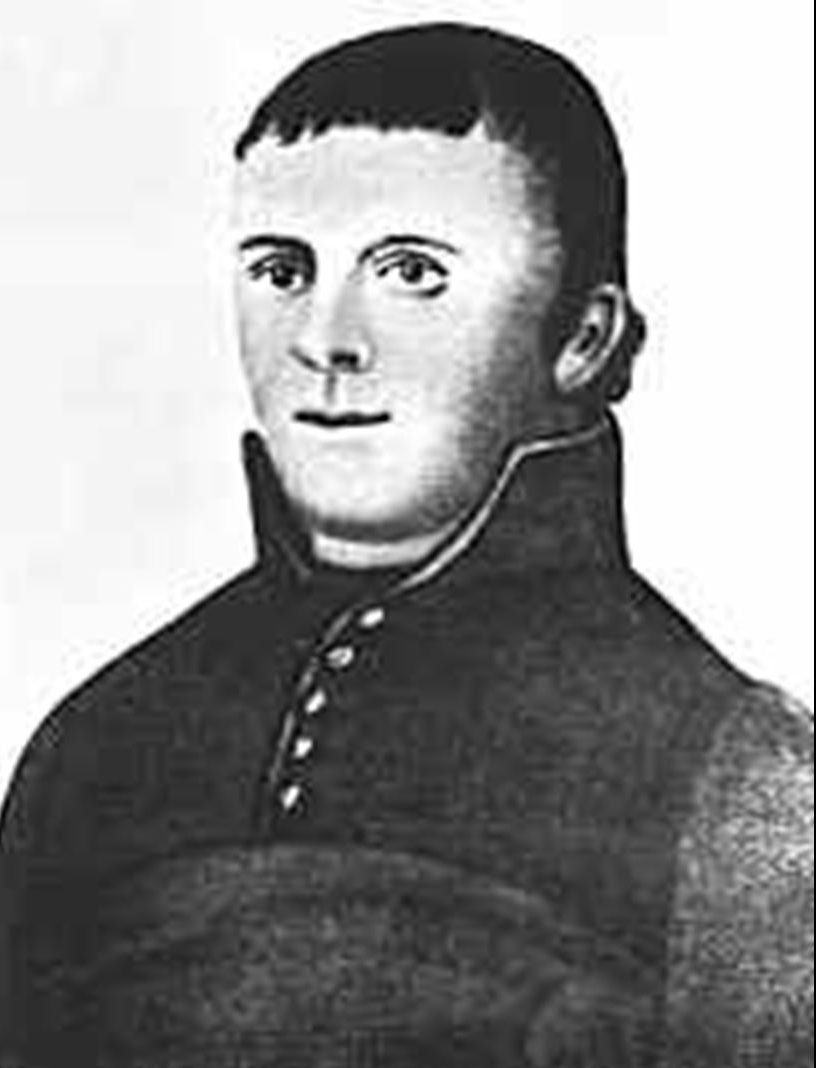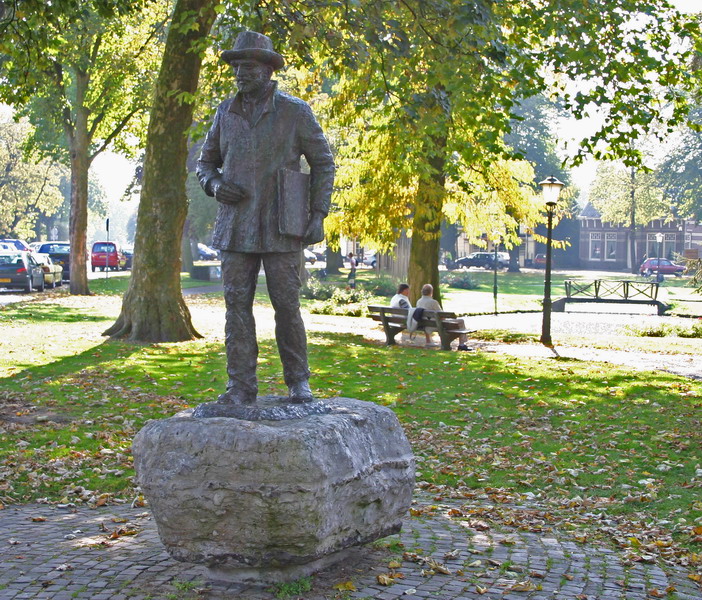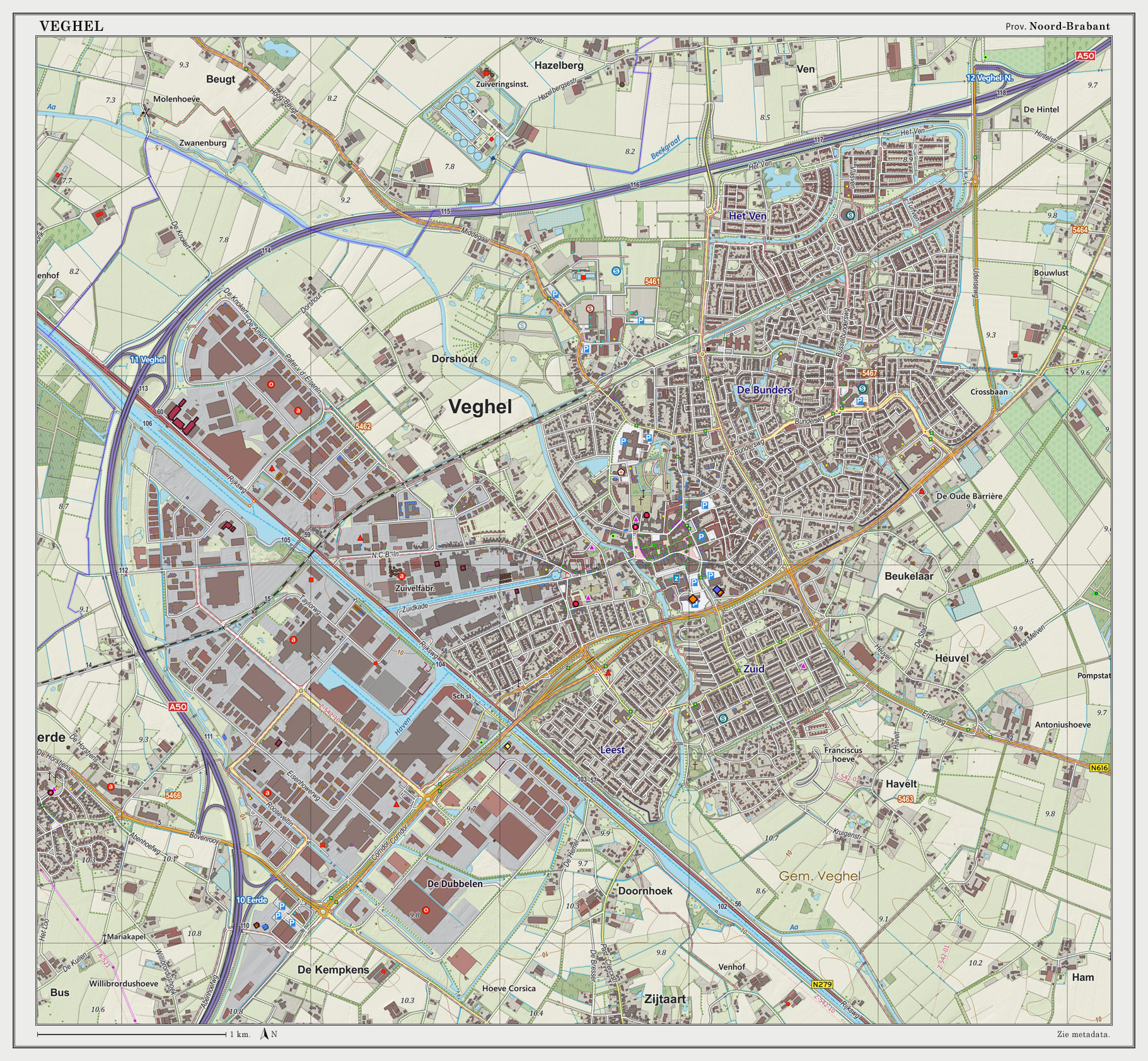|
Uden
Uden () is a town and former municipality in the province of North Brabant, in the Netherlands. Since 2022 it has been part of the new municipality of Maashorst. History Uden was first recorded around 1190 as "Uthen". However, earlier settlements have been found in the areas of modern-day Moleneind, Vorstenburg and Bitswijk and evidence of Ice Age settlements has been found near the hamlet of Slabroek. From 1324 Uden was ruled by the Valkenburg house and became a part of the . After 1397 it became a part of the German duchy of Cleves. Uden was hardly affected by the Eighty Years' War and gained religious freedom in 1631. A result of this was the establishment in the municipality of the Crosiers, who fled from Protestant Dutch oppression in 's-Hertogenbosch in 1638. After the peace of Munster in 1648, Uden remained outside the Dutch republic and was a haven of religious tolerance, and Catholics from the nearby towns of Veghel, Nistelrode and Erp were able to build churche ... [...More Info...] [...Related Items...] OR: [Wikipedia] [Google] [Baidu] |
Maashorst
Maashorst is a Municipalities of the Netherlands, municipality in the south of the Netherlands, formed from the merger of Landerd and Uden. The municipality came into existence on 1 January 2022. The name Maashorst refers to the nature reserve of the same name, which lies between the various village centres.Gemeenten Landerd en Uden worden samen gemeente Maashorst Omroep Brabant, 1 maart 2019 The eastern part belongs to the region of Peel, Netherlands, De Peel. Geography As of 2022, the areas encompassed by the municipality have a population of approximately 57 thousand people. The municipality is bordered by Bernheze to the west, Meierijstad to the southwest, Boekel to the south, Land van Cuijk to the ...[...More Info...] [...Related Items...] OR: [Wikipedia] [Google] [Baidu] |
Little Chute, Wisconsin
Little Chute is a village in Outagamie County, Wisconsin, Outagamie County, Wisconsin, United States. The population was 11,619 at the 2020 United States census, 2020 census. It is immediately east of the city of Appleton, Wisconsin and runs along the Fox River (Illinois River tributary), Fox River. It is a part of the Appleton, Wisconsin Metropolitan Statistical Area. The town was originally established as a trading post by French explorers who called it "Le Petite Chute" (Little Chute). In the late 19th century, it was settled by Dutch Catholic immigrants from North Brabant, led initially by the Dominican Missionary Theodore J. van den Broek from Uden. The town became an outpost of Dutch Catholic immigrants in the Midwest. Little Chute is home to a full-scale Dutch-style working windmill, which has become a tourist attraction. Prior to European exploration it is likely the Mississippian culture tribe, the Oneota lived in the area. The Oneota are believed to be the ancestors of ... [...More Info...] [...Related Items...] OR: [Wikipedia] [Google] [Baidu] |
Kobus Van Der Schlossen
{{no footnotes, date=February 2013 Kobus (or Jacobus) van der Schlossen (died 1695) was a late-seventeenth century Dutch thief who features prominently in folktales from the North Brabant region. After serving as a soldier in the many wars which left the Netherlands in turmoil, he joined a gang of ex-soldiers called 'de zwartmakers' (lit. the detractors). With his robber band 'De Zwarte Bende' he made his home in the vast and impenetrable Slabroek forests near Uden. Eventually he was captured in Uden and imprisoned in Ravenstein Castle (since demolished). He was hanged in 1695 at the gallows of the Lordship of Ravenstein in Velp. Allegedly, 20,000 spectators came to witness the execution. Stories were told about his miraculous escapes from the forces of law. De Brobbelbies, an area of Slabroek which still exists, received its name from one of these stories. One day, as the story goes, Kobus accidentally ran into some law-officers in the woods. When he found he could not outrun ... [...More Info...] [...Related Items...] OR: [Wikipedia] [Google] [Baidu] |
North Brabant
North Brabant ( ; ), also unofficially called Brabant, Dutch Brabant or Hollandic Brabant, is a province in the south of the Netherlands. It borders the provinces of South Holland and Gelderland to the north, Limburg to the east, Zeeland to the west, and the Flemish provinces of Antwerp and Limburg to the south. The northern border follows the Meuse westward to its mouth in the Hollands Diep strait, part of the Rhine–Meuse–Scheldt delta. North Brabant had a population of about 2,626,000 as of January 2023. Major cities in North Brabant are Eindhoven (pop. 231,642), Tilburg (pop. 217,259), Breda (pop. 183,873), its provincial capital 's-Hertogenbosch (pop. 154,205), and Helmond (pop. 94,967) History The Duchy of Brabant was a state of the Holy Roman Empire established in 1183 or 1190. It developed from the Landgraviate of Brabant and formed the heart of the historic Low Countries, part of the Burgundian Netherlands from 1430 and of the Habsburg Netherlands f ... [...More Info...] [...Related Items...] OR: [Wikipedia] [Google] [Baidu] |
Canons Regular Of The Order Of The Holy Cross
The Crosiers, formally known as the Canons Regular of the Order of the Holy Cross (), abbreviated OSC, is a Catholic religious order of canons regular of Pontifical Right for men."Canons Regular of the Order of the Holy Cross (O.S.C.) Crosiers" ''GCatholic.org''. Gabriel Chow. Retrieved 29 February 2016 '' Catholic-Hierarchy.org''. David M. Cheney. Retrieved 29 February 2016 It is one of the Church's oldest religious orders, and membership consists of priests and brothers who live together according to the [...More Info...] [...Related Items...] OR: [Wikipedia] [Google] [Baidu] |
Volkel Air Base
Volkel Air Base () is a military airbase used by the Royal Netherlands Air Force (RNLAF) - Dutch: ''Koninklijke Luchtmacht (KLu)'', located near the village of Volkel, Netherlands. Located in the north-east corner of the province of North Brabant, the air base is home to two F-35 squadrons, No. 312 and No. 313 and a maintenance, logistical, base squadron for the RNLAF. Volkel also houses the 703rd Munitions Support Squadron, part of the 52nd Fighter Wing from the United States Air Force. After more than 50 years, former Prime Minister Ruud Lubbers in 2013 officially confirmed the presence of 22 B61 nuclear bombs at Volkel. In 2021 training with the latest B-61-12 modification began and in December 2023, 14 F-16 could be seen performing an elephant walk (aeronautics) before take off. Description Volkel Air Base is located near the village of Volkel. It is one of several military airfields in the Netherlands, and one of the three major operational bases of the Royal Netherland ... [...More Info...] [...Related Items...] OR: [Wikipedia] [Google] [Baidu] |
Erp, Netherlands
Erp () is a village in southern Netherlands, in the province of North Brabant between 's-Hertogenbosch and Eindhoven. Prior to 1994, Erp was a Municipalities of the Netherlands, municipality consisting of the town of Erp and the villages of Boerdonk and Keldonk. In that year, the municipality was merged with the municipality of Veghel to form one municipality under the latter name. The area of the former municipality of Erp has a population of 6,663, while Veghel has a population of 37,655. The municipality of Veghel, which merged into the new municipality of Meierijstad in 2017, consisted of the towns of Veghel and Erp, and the villages of Boerdonk, Keldonk, Mariaheide, Zijtaart and Eerde. Veghel is 5 km northwest of Erp and other neighboring towns, including Uden (north), Boekel (east), Gemert (southeast), Beek en Donk (south) and Sint-Oedenrode (west). Erp's town hall dates from 1791. It lost its main function when Erp was annexed to Veghel. Both the town hall and the Saint ... [...More Info...] [...Related Items...] OR: [Wikipedia] [Google] [Baidu] |
Veghel
Veghel () is a town and a former municipality in Southern Netherlands. On 1 January 2017 Veghel, together with Schijndel and Sint-Oedenrode, merged into a new municipality called Meierijstad. This created the largest municipality of the province of North Brabant in terms of land area. History The first known settlements date to Roman times and were established near the River Aa. The oldest written record of Veghel dates from 1225. It is a document of the Abbey of Berne, written in Latin on a piece of parchment, and describes several properties owned by the abbey. Among those is an estate located in the settlement of "Vehchele". In 1310, John II of Brabant granted the inhabitants the right to use common grounds. For some decades in the 16th and 17th century, the municipality was ruled by the Lords Van Erp; they resided at their castle of Frisselsteijn in Veghel. In 1648 Veghel became part of the Republic of the Seven United Netherlands. As a former part of the Duchy o ... [...More Info...] [...Related Items...] OR: [Wikipedia] [Google] [Baidu] |
Theodore J
Theodore may refer to: Places * Theodore, Australian Capital Territory, Australia * Theodore, Queensland, Australia * Theodore, Saskatchewan, Canada * Theodore, Alabama, United States * Theodore Reservoir, in Saskatchewan People * Theodore (given name), including a list of people with the name ** Theodore Roosevelt, 26th President of the United States **Grand Wizzard Theodore, American musician and DJ * Theodore (surname), including a list of people with the name Fictional characters * T-Bag (''Prison Break'') (Theodore Bagwell), in ''Prison Break'' * T-Dog (''The Walking Dead'') (Theodore Douglas), in ''The Walking Dead'' * Theodore Huxtable, in ''The Cosby Show'' * Theodore, in ''Alvin and the Chipmunks'' * Theodore Grambell, or CatNap, in video game ''Poppy Playtime'' * Theodore "The Roach" Roachmont, from Supernoobs Other uses * Theodore (horse), a British Thoroughbred racehorse * Theodore Racing, a Formula One constructor See also * Theodoros, or Theodorus * Principa ... [...More Info...] [...Related Items...] OR: [Wikipedia] [Google] [Baidu] |
Meteorite
A meteorite is a rock (geology), rock that originated in outer space and has fallen to the surface of a planet or Natural satellite, moon. When the original object enters the atmosphere, various factors such as friction, pressure, and chemical interactions with the atmospheric gases cause it to heat up and radiate energy. It then becomes a meteor and forms a Meteoroid#Fireball, fireball, also known as a shooting star; astronomers call the brightest examples "Bolide#Astronomy, bolides". Once it settles on the larger body's surface, the meteor becomes a meteorite. Meteorites vary greatly in size. For geologists, a bolide is a meteorite large enough to create an impact crater. Meteorites that are recovered after being observed as they transit the atmosphere and impact event, impact Earth are called meteorite falls. All others are known as meteorite finds. Meteorites have traditionally been divided into three broad categories: stony meteorites that are rocks, mainly composed of sil ... [...More Info...] [...Related Items...] OR: [Wikipedia] [Google] [Baidu] |
Kingdom Of The Netherlands
The Kingdom of the Netherlands (, ;, , ), commonly known simply as the Netherlands, is a sovereign state consisting of a collection of constituent territories united under the monarch of the Netherlands, who functions as head of state. The realm is not a federation; it is a unitary monarchy with its largest subdivision, the eponymous Netherlands, predominantly located in Northwestern Europe and with several smaller island territories located in the Caribbean. The four subdivisions of the Kingdom— Aruba, Curaçao, the Netherlands, and Sint Maarten—are constituent countries ( in Dutch; singular: ) and participate on a basis of equality as partners in the Kingdom. In practice, however, most of the Kingdom's affairs are administered by the Netherlands—which comprises roughly 98% of the Kingdom's land area and population—on behalf of the entire Kingdom. Consequently, Aruba, Curaçao, and Sint Maarten are dependent on the Netherlands for matters like foreign policy and ... [...More Info...] [...Related Items...] OR: [Wikipedia] [Google] [Baidu] |
Eighty Years' War
The Eighty Years' War or Dutch Revolt (; 1566/1568–1648) was an armed conflict in the Habsburg Netherlands between disparate groups of rebels and the Spanish Empire, Spanish government. The Origins of the Eighty Years' War, causes of the war included the Reformation, Centralised state, centralisation, excessive taxation, and the rights and privileges of the Dutch nobility and cities. After Eighty Years' War, 1566–1572, the initial stages, Philip II of Spain, the sovereign of the Netherlands, deployed Army of Flanders, his armies and Eighty Years' War, 1572–1576, regained control over most of the rebel-held territories. However, Spanish Fury, widespread mutinies in the Spanish army caused a general uprising. Under the leadership of the exiled William the Silent, the Catholic and Protestant-dominated provinces sought to establish religious peace while jointly opposing the king's regime with the Pacification of Ghent, but the Eighty Years' War, 1576–1579, general rebelli ... [...More Info...] [...Related Items...] OR: [Wikipedia] [Google] [Baidu] |





